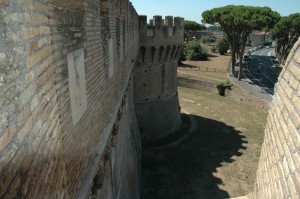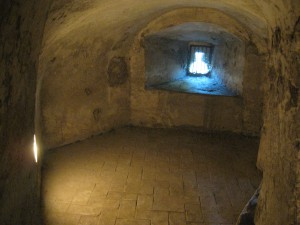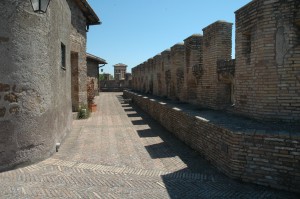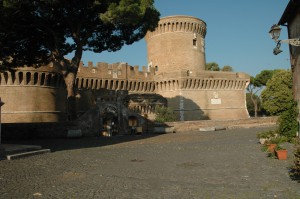
The Castello di Giulio II (Julius the Second’s Castle) once commanded the last bend of the River Tiber before it emptied into the sea
Italy’s financial woes have seldom been far from the news for some time. But there is one casualty of the shortage of money that’s infrequently reported – the reduced funding for the country’s museums and monuments.
A half-hour train trip from central Rome lies a little-known historical landmark, that may soon be forced to close its gates. The ‘Castello di Giulio II’ or Julius the Second’s Castle, is a centuries-old structure.
Overlooking the ruins of Ostia Antica, the ancient harbour city, it has always been over-shadowed by its more famous neighbour, but still it has managed to thrive. Its future, however, is uncertain.
“We have a real shortage of staff lately, like all cultural heritage sites,” Castle guide Donatella Dotti says. “You can only visit the castle now on Thursdays.”
Donatella Dotti has been been conducting tours of the castle since 1996. Until recently, it kept her busy all week. For decades, the Castello was open every day except Monday.
But recently the tours were drastically cut. Now they take place just once a week – at 11am on Thursdays, and then, only if visitors phone to book first.
Confused tourists often cluster around the sign on the Castello gate, advising them of this fact. ‘Thursday only?’ they ask. ‘Yes, just Thursday,’ passing residents of the nearby village reply.
The Castello di Giulio II is one of just two castles in the city of Rome.
Cardinal Giuliano della Rovere financed its construction between 1483 and 1487, entrusting the work to Florentine architect Baccio Pontelli. (The Cardinal became Pope Julius the Second or Giulio II, famous for being Michelangelo’s patron.)
Julius the Second’s castle once had immense strategic importance.
Customs officials at the Castello collected duties for the Vatican from ships sailing to Rome. It protected the last bend of the Tiber, before the river emptied into the sea.
Constructed of marble and other materials from the nearby ruins, it was built for war.
From the battlements above, where the cannons were fired and boiling oil poured through channels, to its moat below, everything was designed for defence.
“There are ovens for cooking bread, ammunition stores, grain stores and mills and so on. There is everything needed to survive a siege – even one lasting for months,” Donatella explains to visitors, as she conducts a tour.
The castle also reflects Pope Julius the Second’s great love of the arts.
Frescos, created by artists of the Baldassarre Peruzzi school, remain over the main staircase leading to the papal apartments.
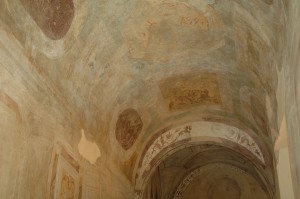
Frescoes, painted by artists of the Baldassare Peruzzi school, over the main staircase of the castle
A restoration effort four years ago revealed paintings of the trials of Hercules and cameos of ancient Roman emperors.
But Donatella Dotti says the restoration work has come to a halt before it is complete.
“These frescos were supposed to be restored in three phases,” she says.
“The first two phases are finished. They should start soon on the third. I don’t know when (it will happen). The sooner you begin the work, the sooner you stop the decay,” she explains.
But in-cash strapped Italy the heritage dollar is stretched too thin.
There are more UNESCO World Heritage sites here than in any other nation, but in the past few years, the culture budget has been drastically reduced. There’s barely enough to maintain and preserve them. There’s also a critical shortage of staff.
Recently the government proposed the sale of hundreds of historic buildings, to reduce debt. The Castello is just one of many needy venues.
“We want to be optimistic and hope the castle will be open more often in the future,” Donatella Dotti says. “People like it a lot. The tour is always full and the castle is worth it.”
The castle’s fortunes have always risen and fallen.
In the 1500s, barely sixty years after it was built, there was a terrible storm. The Tiber, which once flowed just past the moat, changed its course, leaving the Castello high and dry.
A year after surviving a Spanish siege, overnight, the castle was rendered obsolete.
For three centuries afterwards, it languished – the centre of malaria-ridden swamp. At most it was used as a machinery store and a prison.
“The prisoners at the castle were taken out each day to move the earth from the ruins of Ostia Antica. The history of the castle is linked to the dig in this way.”
In the 1900s, the castle underwent extensive restoration. It’s now almost back to its former condition.
But jockeying for attention amid thousands of other historical treasures in Italy – Roman ruins, Renaissance churches and priceless artworks –it’s struggling for recognition.
So though it’s survived a stormy past – fighting off invaders and tempests, and housing prisoners and Popes in the centuries since it was commissioned by Michelangelo’s patron, now its future is uncertain.
(Article and photos on Deutsche-Welle website, accompanying radio feature story)
c2015 Jean Di Marino
